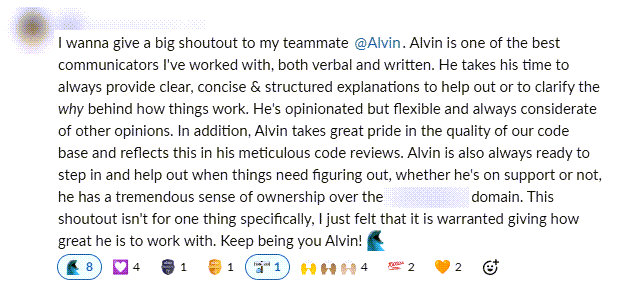Dive 115: What successful people know about “doing the right thing”
Hey, it’s Alvin!
My most successful mentors taught me one of the greatest leadership lessons that can be summed up in three key lines:
Do the right thing when it’s hard.
Do the right thing when no one’s looking.
Do the right thing when you don’t have to.
I recently got to put this into practice, leading to one of the most rewarding moments in my software development career. These same three principles are just as vital to success in your life, which is why I’m sharing my story. In fact, we can take it even further.
I’ll also share a recent story of a woman who took a ball away from a young boy at a baseball game as a counterexample for why these three principles are critical if you want to help build a stronger, healthier society. For yourself. For your family. And for future generations. You don’t need to know about baseball. You don’t even need to like it.
A Friend in Need
Every software development team has two key tasks:
Add new features.
Fix existing ones.
But how does a productive software development team juggle feature work with bug fixes?
In my small team of three, two of us would focus on new features, while the third would handle support requests to fix bugs and address other tech issues. At least, that’s the ideal.
But one day, I noticed our support member bombarded with three huge requests from three different people at the same time. All supposedly urgent.
So, I pulled him aside for a quick meeting. There, we worked together to prioritize the three items. They may have all been “urgent,” but there are still some more urgent than others. We pair-programmed on an issue and split the remaining tasks between me and him. When I wrapped up my task, I continued taking on the smaller support requests so he could focus on the last major, urgent task on his plate.
Some day after all the fires were put out, I got this company-wide shoutout from that teammate:
I didn’t have to do any of that.
I wasn’t on support. It wasn’t my turn. I had my own work to do.
I did it in part because I felt bad for him. I’ve been in his position before. It’s overwhelming.
I also did it in honour and out of respect for all that my greatest mentors did for me in my younger years. They too stepped in to help me out when they did not have to. They also took on extra work they were not assigned to.
They helped when it was hard.
They helped when no one else was looking.
They helped when they didn’t have to.
But because of their selfless actions, our teams were always better off. Especially in the long run. Why?
Because it creates an unspoken sentiment: we care enough about one another to have each other’s backs. It shows we want what’s best for the team.
But this is just as true in all other aspects of life. Including yours. And we can better understand why by looking at a counterexample.
“Karen Ball Snatcher”
Introducing, “Karen Ball Snatcher.” Her real name isn’t known. Yet. But what earned her this nickname from the internet?
It started with a baseball hit for a home run into an outfield seating area in a Miami ballpark. The ball bounces around a bit before a man grabs it, raises it in the air with his right hand in a moment of victory as he walks back over to where his family is sitting, and places it in his son’s baseball glove.
Moments later, a grown woman approaches the man and starts screaming in his face. Purportedly, she felt entitled to the ball because it landed in her area. But anyone familiar with the game knows that whoever comes up with the ball first gets to keep it no matter where it lands.
The father just wanted to spend quality time with his family. He knew his priorities. So, he takes the ball out of his son’s glove, and hands to the badgering woman, so he and his family can just move on with their lives. You can see the entire exchange here.
The right, but hard, action to take would have been for the woman to let it go. Let the boy have the ball. Or at least give it back. Or at least end it there. Of course, Karen Ball Snatcher wasn’t done.
Because nearby fans were voicing their displeasure, she went right up to their faces to lecture them.
What did she do in response to all the surrounding fans booing her?
She gives them all the middle finger, ball in hand, of course.
Part of what made this incident so outrageous is that it’s rare. In fact, there’s a heartwarming story of a “cool guy in sunglasses” catching a home run ball in a completely different game. He didn’t have to give the ball away. He caught it. But upon catching the ball, he tosses it to a young man a few rows in front. If the story ended there, it wouldn’t be anything special.
But later in the game, the same boy caught another home run ball. And what did he do with it?
He pointed at the “cool guy in sunglasses” and tossed the ball back to him.
This isn’t just another feel-good story. A life lesson dwells below the surface here, which is that people are always looking towards one another to clue in on how to behave in society. Psychologist Robert Cialdini calls this the theory of social proof. We influence one another by how we act. Good behaviours beget good behaviours, leading to a healthier society. Bad behaviours beget bad behaviours, leading to societal rot.
When the “cool guy in sunglasses” tossed the ball to the boy, it’s not just the boy who benefits. Society benefits. Because it’s not just that everyone sees what proper etiquette is in that situation. Everyone also sees generosity happening, which encourages others to be generous.
On the other hand, when Karen Ball Snatcher takes a ball from a child and then gives everyone the middle finger in defiance, what is she signalling? She’s encouraging people to take pride in being selfish. What “Karen” didn’t understand was that the boos she got were not just for her. They were for her actions because her failure to do the right thing is harmful to society. The collective booing is a reminder to the rest of society that an adult woman shouldn’t behave like a spoiled little brat. Even though it would’ve been hard for her.
I didn’t say much about doing the right thing when no one’s looking. But the reason for that is simple. It’s hard to just flip the switch when you need to. If you make a habit of doing the right thing all the time, it’s easier to do it when you need to do it most. You have momentum.
The most successful people I know follow 3 key principles:
Do the right thing when it’s hard.
Do the right thing when no one’s looking.
Do the right thing when you don’t have to.
Because a key to success is being a positive role model to those around you.
Why?
Because unless you live in total isolation, those around you affect your life. And by extension, your success. It’s unreasonable to expect others to do the right thing if you can’t. Or won’t.
When you lead the way by taking the right actions, you’re elevating those around you.
When you elevate those around you, you elevate yourself.
When you elevate yourself, you reach higher levels.
So, don’t be Karen the Ball Snatcher.
Be the cool guy with sunglasses.
Lead by example.
Reach for the stars.
Reply to belowthesurfacetop@gmail.com if you have questions or comments. Check out Dive 57, where I dive more into why the greatest leaders are elevators:
Thank you for reading. Lead by example. And I’ll see you in the next one.






